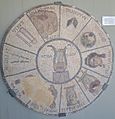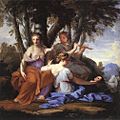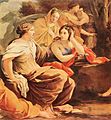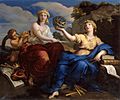Muse facts for kids
The Muses are goddesses from Greek mythology. They were believed to inspire people in different arts and sciences. These special goddesses were the daughters of Zeus, the king of the gods, and Mnemosyne, the goddess of memory.
Most commonly, there are nine Muses:
- Kalliope (or Calliope) was the oldest and wisest. She was the muse of epic poetry, which are long poems about heroes. She was also the mother of Orpheus, a famous musician.
- Euterpe was the muse of music and lyric poetry (poems that express feelings). She loved playing the flute and some stories say she even invented the double flute.
- Klio (also Kleio or Clio) was the muse of history. She helped people remember and record important events.
- Erato was the muse of love poetry. She inspired poets to write about love and romance.
- Melpomene was the muse of tragedy. She inspired plays that had sad or serious endings.
- Polyhymnia was the muse of sacred poetry, like hymns (songs of praise). She also inspired geometry and pantomime (acting without words).
- Terpsichore was the muse of dance. She inspired dancers and choreographers.
- Thalia was the muse of comedy. She inspired plays that were funny and had happy endings.
- Urania was the muse of astronomy (the study of stars and planets) and astrology (the belief that stars influence human lives).
The word muse is also used today for a person or thing that inspires someone else, especially an artist. For example, an artist's "muse" might be the person or idea that gives them creative thoughts for a poetry or a song.
Images for kids
-
The nine Muses on a Roman sarcophagus (a stone coffin) from the second century AD. It is in the Louvre museum in Paris.
-
Clio, Euterpe, and Thalia, painted by Eustache Le Sueur, around 1652–1655.
-
Melpomene and Polyhymnia, a sculpture at the Palacio de Bellas Artes in Mexico.
-
The Car of History, a special chariot clock made by Carlo Franzoni in 1819. It shows Clio and is kept in the National Statuary Hall Collection in the United States Capitol.
-
A painting showing Mount Parnassus, a mountain sacred to Apollo and the Muses.
See also
 In Spanish: Musa para niños
In Spanish: Musa para niños

















